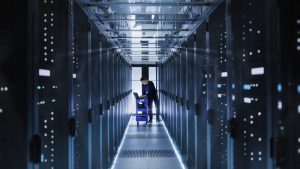With contribution from:
Sharif Fotouh: Founder and CEO of Compass EdgePoint
At SxSW this year, connectivity is more important than ever before as AI, IoT, and edge computing play a bigger role in delivering high-quality video, music, and gaming to consumers each day. With this in mind, film, music and interactive content stand to suffer if connectivity is threatened.
In the panel on March 9 at 2pm CT, How Connectivity Will Control Everything We Know, Sharif Fotouh, Founder and CEO of Compass EdgePoint, will help uncover why these types of computing are so critical to connectivity. In the meantime, however, I sat down with Sharif to discuss how his past experience at Google, and his early work with the IoT and edge computing, position him as a connectivity expert.
1. How did your time at Google influence the launch of your company, Compass EdgePoint?
Sharif Fotouh: At Google, I led the national team responsible for rolling out the facilities and IT supporting the Google Fiber network. Over the years, a few things became apparent in these processes that drove me to eventually leave and found EdgePoint, now Compass EdgePoint. First, I became intimately aware of the inherent limitations of the national infrastructure, especially the datacenters and the fiber optic networks that support the internet. It was startling when I realized that the majority of compute and storage capacity is concentrated into a half-dozen locations in the US, and even more so, that there are just a handful of major fiber routes distributing access from these sites across the country.
Second, the internet as we know it, is really just a better television broadcasting network. More than 80% of internet traffic today is video, with most of that percentage being made up of streaming video downloads (i.e. Netflix, Youtube, etc). The architecture of the internet has adapted to this use case, and is reliant on the crutch of local caching to band aid over infrastructure shortfalls. While at Google Fiber, we looked to give end users an order-of-magnitude jump in bandwidth, and it became clear to me that the internet’s entire infrastructure, not just one network specifically, would collapse if a non-linear, non-video use case for that bandwidth ever materialized.
Finally, living in Silicon Valley during my time at Google truly immersed me in the conversations about the next generation applications that are quickly becoming actual products. A world of interconnected everything, from cars driving themselves to virtual realities were becoming rapidly developed, while just a few years prior these concepts were straight out of a great science fiction novel. These things are rapidly being created and tested today, and they require a level of latency and localized compute and storage that simply aren’t available.
2. A wide variety of edge computing applications came to light in 2017 due to the evolution of cloud computing and the IoT, although the concept has been in use for far longer. When did you first realize the importance of edge computing for modern businesses?
Fotouh: I think this is one of the biggest fallacies when it comes to the “edge” and the associated buzzword-laden hype. The edge isn’t a crystal ball prediction or a concept for some future generation to apply. The edge is already here.
When I think about the edge I’m looking at our most important facilities – hospitals, schools, factories, and stores. All of these facilities already have a critical footprint of local “edge” IT that runs their power and cooling systems, badge readers, cameras, life safety, billing, and the computers and networks for their site.
Today a facilities nerve center is tucked away in a repurposed janitors closet; likely with a mop and bucket nearby. If something were to happen to that closet and the systems within it, you might as well send everyone home and shut the doors for the day.
I think the growing importance of that closet has snuck up on us, and this criticality will only increase as we digitize and automate more functions. Likewise, the requirements from a power, cooling and space perspective have been, and will only continue to keep, growing.
3. The early days of the IoT were characterized by the critical role of cloud platforms. With this in mind, what role do you see cloud platforms playing in the future as edge computing, connectivity, and applications continue to evolve?
Fotouh: This is a point of contention in a lot of conversations with industry insiders and analysts. The big central cloud facilities serve a clear purpose today, and will continue to do so. The efficiencies you get from consolidating and going bigger; it’s a tale as old as time.
Edge growth, and the continued drive for capacity to get closer to users, isn’t going to detract from these existing large cloud facilities, but rather create a new space and opportunity.
Today, all the applications and users are served well from a handful of gigantic warehouses around the country. Big trucks deliver pallets of data across the country, and for the most part that system works since most of that data is video coming from the warehouse to our houses. With new applications however, there’s a need for the corner store. It’s just not economical or convenient for a pack of gum or chapstick to come from across the country.
Needing corner stores doesn’t eliminate the need for a central warehouse. The internet of the future will need a rich set of offerings that span from the cloud and core all the way to the edge.
4. Addressing security and privacy is a common concern for everyone these days, how do you think consumers feel about the penetration of IoT, cloud, and edge, in their daily lives?
Fotouh: [Laughs] Scared? I mean, heck, I’m scared myself sometimes. Every technological advancement in human history comes with benefits and risks. Humanity discovered fire and simultaneously discovered how to keep their family warm and also how to burn down the whole village.
Take the Internet of Things (IoT) as an example. I’m super excited to have that “Jetsons” home we all grew up watching on Saturday morning cartoons. Every time I run out of creamer for my coffee, or have to get back out of bed because I forgot to turn off a light in my house, I look forward to the future of a connected home. At the same time, I’m not so excited with my coffee machine blasting me with an ad for Coffee-mate first thing in the morning, or with my light-bulb manufacturer knowing that I still go to bed with a nightlight.
I think, as consumers, we aren’t taking enough responsibility for our own protections. We need to demand technology companies be responsible stewards of our data, and vote with our dollars when they aren’t. Let’s stop mortgaging our privacy and security for free email and music; let’s not sell Manhattan for beads and trinkets.
Similarly, as voters, we aren’t taking enough responsibility for the role government has to play here. Why hasn’t the Federal Communications Commission (FCC) established the same protections on email that we’ve always enjoyed with physical mail? Why is a FaceTime call less protected, legally, than my phone call? Our politicians, and thereby our laws, haven’t kept up with the times and the pace of technological advances.
5. Let’s close with a prediction. One thing the tech industry is acutely aware of is the rapid pace of data generation around the world. What do you see as the next trend to solve for this growth? The next big concern?
Fotouh: Not to plug my own business, but personally and professionally, I’m putting my chips on edge computing. To stick my neck out a little further by getting more specific, I’m betting on sensors being the biggest driver. Digital sensors keep getting better, cheaper, and by virtue of that more ubiquitous. Today’s average cellphone has a collection of photo, sound, light, motion, and location sensors that’d make both a fighter pilot and a movie producer from the 1950’s jealous.
A step counter, those early FitBits as an example, used to be a $100 device. Now they’re built into shoes. I’m sure we’ll have GPS in our soles soon enough.
At CES this year, there was a funny piece of tech announced; a robot that folded laundry. Now as much as I hate folding laundry, I hang everything by the way, what really piqued my curiosity is that the machine required every piece of clothing to have an NFC tag so it could identify how to fold it.
It sounds kind of nuts, but then again NFC tags cost fractions of a cent so it’s less an economic barrier than about industry adoption. The concept made me ask, why can’t my washer and dryer detect and set the optimal cycle for whatever clothes I load in, or warn me that my bright red socks snuck into my whites?
Laundry aside, as sensors go everywhere, all that data also has to go somewhere. And again, I don’t think my bright red socks need to send their wear statistics all the way to some datacenter in Ashburn.



